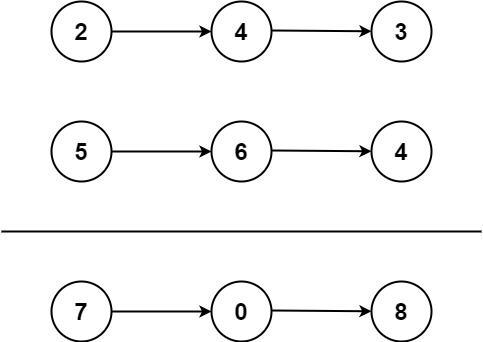[Coding011] LeetCode 2
Add Two Numbers
Get the knowledge flowing and circulating! :)
目录
题目: 2. Add Two Numbers
You are given two non-empty linked lists representing two non-negative integers. The digits are stored in reverse order, and each of their nodes contains a single digit. Add the two numbers and return the sum as a linked list.
You may assume the two numbers do not contain any leading zero, except the number 0 itself.
Example 1:

xxxxxxxxxx31Input: l1 = [2,4,3], l2 = [5,6,4]2Output: [7,0,8]3Explanation: 342 + 465 = 807.
Example 2:
xxxxxxxxxx21Input: l1 = [0], l2 = [0]2Output: [0]
Example 3:
xxxxxxxxxx21Input: l1 = [9,9,9,9,9,9,9], l2 = [9,9,9,9]2Output: [8,9,9,9,0,0,0,1]
Constraints:
The number of nodes in each linked list is in the range
[1, 100].0 <= Node.val <= 9It is guaranteed that the list represents a number that does not have leading zeros.
代码1
xxxxxxxxxx661/**2 * Definition for singly-linked list.3 * public class ListNode {4 * int val;5 * ListNode next;6 * ListNode() {}7 * ListNode(int val) { this.val = val; }8 * ListNode(int val, ListNode next) { this.val = val; this.next = next; }9 * }10 */11class Solution {12 public ListNode addTwoNumbers(ListNode l1, ListNode l2) {13
14 // dummy是伪结点(经典步骤)15 ListNode dummy = new ListNode(0); // 用于最后返回,dummy.next16 ListNode r = dummy; // r是在过程中操作的;17
18 int res = 0;19 int carry = 0;20
21 while (l1 != null || l2 != null)22 {23
24 if (l1 != null && l2 != null) // 都有值25 {26 res = l1.val + l2.val + carry; 27 l1 = l1.next;28 l2 = l2.next;29 }30 else if (l1 != null && l2 == null) // 一个有值,一个没有31 {32 res = l1.val + carry;33 l1 = l1.next;34 }35 else if (l2 != null && l1 == null) // 一个有值,一个没有36 {37 res = l2.val + carry;38 l2 = l2.next;39 }40
41 if (res >= 10) // 如果结果大于等于10,那就进位42 {43 carry = res / 10;44 res = res - carry * 10;45 }46 else // 否则不进位47 {48 carry = 0;49 }50
51 // 新建一个结点,并且连接在dummy为首结点的这条链后面52 ListNode temp = new ListNode(res);53 r.next = temp;54 r = r.next;55 }56
57 if (carry > 0) // 1 + 9 = 10(结果可能超过1位,源自进位位)58 {59 r.next = new ListNode(carry); // 所以carry要单独再判断一下60 r = r.next;61 }62
63 return dummy.next;64 65 }66}代码2
xxxxxxxxxx391
2class Solution {3 public ListNode addTwoNumbers(ListNode l1, ListNode l2) {4
5 // dummy是伪结点(经典步骤)6 ListNode dummy = new ListNode(0); // 用于最后返回,dummy.next7 ListNode r = dummy; // r是在过程中操作的;8
9 int res = 0;10 int carry = 0;11
12 while (l1 != null || l2 != null)13 {14 // 相比代码1,每次都判断l1, l215 int x = (l1 != null) ? l1.val : 0; // 条件表达式16 int y = (l2 != null) ? l2.val : 0;17
18 res = x + y + carry;19
20 carry = res / 10;21 res = res - carry * 10;22
23 r.next = new ListNode(res);24 r = r.next;25
26 // 相比代码1,每次都判断l1, l227 if (l1 != null) l1 = l1.next;28 if (l2 != null) l2 = l2.next;29
30 }31
32 if (carry > 0)33 {34 r.next = new ListNode(carry); // 更节省了!35 }36
37 return dummy.next;38 }39}复杂度分析
有两个链表,复杂度应该是:
★ 知识点积累 (Java)
dummy伪结点的使用,更熟悉了一点;
先新建
dummy结点;然后用一个指针
p指向dummy;然后只操作这个指针
p,dummy不动,这样的话,最后只需要返回dummy即可!
两数之和要有进位位,进位位的经典计算方法
carry = sum / 10;
sum = sum - carry * 10;
单链表类的使用
新建一个结点:ListNode temp = new ListNode(val);
链接一个结点:p.next = temp;
条件表达式的使用
xxxxxxxxxx121if (l1 != null)2{3x = l1.val;4}5else6{7x = 0;8}910// 等价于1112x = (l1 != null) ? l1.val : 0;